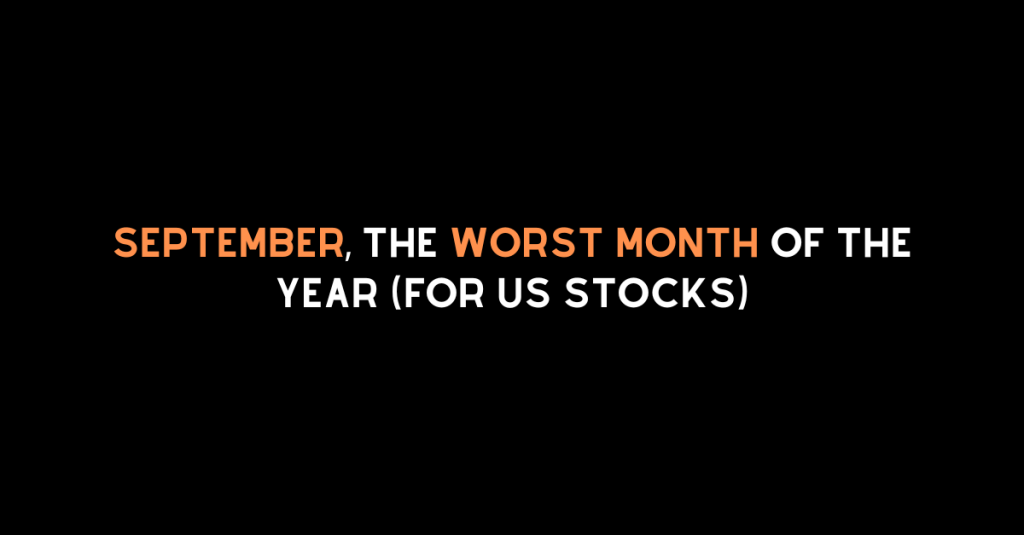“Summer is over,” was one of the most prevalent expressions I heard this week. Even if we don’t want to admit it, it is true. The month of September heralds the arrival of autumn and the colder months that we have all been dreading. September has long been regarded as a challenging month for the US stock market, with a historical average decline of 4.50%. Despite occasional rallies, the month consistently shows negative performance, raising concerns among investors.
Why is September Historically the Worst Month for the US Stock Market?
September is historically the worst month for the US stock market, with an average decline of 4.50% since 1928. Contributing factors include profit-taking after summer, tax-loss harvesting, and adjustments by mutual funds. Additionally, downgrades following Q2 earnings often lead to increased market volatility. Understanding these trends can help investors prepare for potential downturns. Aside from rain, storms, and shorter days, September is also renowned as the worst month of the year for the US stock market. Despite a rally in the overall market, both the S&P 500 and the Dow Jones sank severely in September and 2020 last year.
A Historical Overview of September’s Market Performance
Let us take a closer look at previous performances. Below are the years when stocks fell the most during the month of September. At this point, we should know that there have been 50 negative Septembers in total since 1928 (94 years), with an average performance of -4.50%. Last year, the S&P 500 concluded September down -4.76%, which was worse than the average.
Since 2000, stocks finished in negative territory in September eleven times. We should only look at the past if they are willing to draw conclusions about the future performance of stock markets. What is the influence of a “negative” September on the following months?
Some analysts believe that September’s negative trend is not just coincidental but is driven by several key factors, including profit-taking after summer, tax-loss harvesting, and adjustments by mutual funds. Additionally, technical factors such as downgrades by sell-side analysts following Q2 earnings also play a significant role Following the worst 21 Septembers, only nine of the following Octobers registered a negative performance, and out of these nine, two cases had US elections. In addition to that, some years experienced crises, such as 1929 (Wall Street Crash of 1929), 1937 (Recession of 1936–37),1962 (Kennedy Slide), 2000 (Dot-com bubble), 2008 (the GFC), 2020 (Covid-19 pandemic).
What are some explanations for this common phenomenon?
When investors return from their summer vacation in September, it is usually anticipated that they will want to sell particular holdings in order to lock in profits for the year. Others argue that this is the time of year when families want funds to cover tuition or school supplies. Furthermore, September marks the start of the season when mutual fund companies begin to pay distributions, which may result in some tax selling.
While these factors may play a part, the underlying culprit is likely to be more technical.
Every year, sell-side analysts are excessively optimistic at the start, forcing them to lower their forecasts later, typically after the second-quarter earnings season closes in August. These downgrades usually have an immediate impact on the market, forcing some institutional investors to de-risk some of their positions.
In any case, some analysts anticipate that equities will suffer once more in September. On the surface, it appears to make sense, particularly in light of recent market losses and the persistent impact of high inflation and rising interest rates.
What are the expectations for this year?
Some investors believe that this year will be different because much of the de-risking has already occurred in the first half of the year. As a result, once experts have finished issuing downgrades this time, many companies will become even cheaper, and institutional investors will leap in and be more active than usual.
On the other hand, if the stock market closes lower this year in September, it could be a sign that the recession is gaining momentum and we will witness a true stock market crash.
One-Signal’s Performance in September
Whatever the analysts determine, the chances are 50:50 that the market will prove them right. Everyone else’s predictions will be revised in retrospect. We can disregard the noise at One-Signal because we consistently outperformed our benchmark throughout the month of September. True, past performance is not always an indicator of future performance; but our excitement for the coming month continues to build on this year’s momentum. September’s historical performance provides valuable insights into market behavior. While past trends indicate potential risks, savvy investors can use this information to navigate the market effectively. Stay informed and keep a close eye on September’s developments as we head into the colder months.
Data Source: Yahoo Finance
